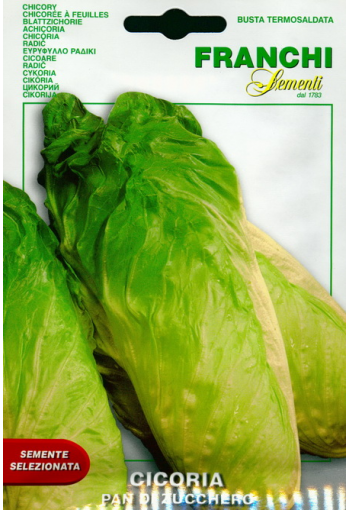Ex Tax: 0.69€
Mid-late variety of special selection "Sugar loaf".
Improves digestion.
As a salad, 2 types are grown - chicory endive and chicory witloof.
Chicory leaves are rich in nutrients: they contain ascorbic acid, carotene, mineral salts, proteins, sugars, as well as inulin and intibin, which cause a slight bitterness.
Salad chicory has medicinal properties. It contains nitric acid, sulfate and hydrochloric acid potassium salts, which improve kidney function.
Inulin has a regulating effect on the body's metabolism and is used as a sugar substitute in diabetes.
Intibin improves the functioning of the digestive system, the activity of the liver, gallbladder, pancreas, cardiovascular system, has a positive effect on the hematopoietic organs.
Chicory endive is grown annually and used as a salad. The shape with a weakly cut leaf blade is known as escarole salat.
The cultivation technique is similar to that of an ordinary salad. Seeds of leaf chicory is sown not only in spring, but also in summer (in July). Plants in this case can remain in the field until frost and retain food quality during thawing. It is possible to store endive rosettes in a trench in the basement, which allows prolonging the use of this valuable product.
Unlike endive, witloof chicory is able to form, when distilled in winter, dense heads of juicy crispy leaves, which are used as a salad or stewed. But there are also special varieties of this type - for fresh consumption. These include the Palla Rossa variety.
It is sown in open ground in June-July in a sunny place according to the scheme of 30 by 30 cm. The seeding rate is 0.4-0.6 g / m2, the seeding depth is 1-1.5 cm.
Maintenance is usual: weeding, loosening the row spacing. Harvested before the onset of frost.
Eng.: Witloof Chicory. Suom.: Salaattisikuri. Sven.: Sockertoppsallat. Bot.: Cichorium intybus var. sativum.
* From simple to complex.
Chicory is used in any form. Very often it is eaten simply raw. The head of cabbage is disassembled into leaves, which are washed and put on a plate - without any dressing. Chicory leaves can themselves become a "plate" that can be filled with anything: chopped egg, minced meat, pate ...
It is also good to cut the heads of cabbage into circles, season with mayonnaise, sour cream or béchamel sauce. They can be served with blue cheeses, baked fish, oysters, or fruit - especially citrus. Try chicory salads. Toss it with apples and hazelnuts, or thin green beans, walnuts and grapes, or beets seasoned with balsamic vinegar. In Belgium they make a salad with yogurt and carrots, in Italy - with dandelions and mustard dressing, in France - with garlic, ham and croutons.
In Europe, chicory is traditionally served as a side dish. To do this, it is boiled for 15 minutes in boiling salted water and eaten with butter, as well as stewed and seasoned with sour cream sauce, fried and served with meat and fish dishes. Boiled until half cooked, chicory is baked in the oven with apples, cheese or ham. It makes a particularly tender, thick soup - velute.
BY THE WAY:
In Europe, chicory began to be cultivated in the 18th century: the roasted and ground roots of the plant were added to coffee, an expensive colonial commodity.
Unlike natural coffee, chicory coffee does not contain potent substances and does not have an exciting effect on the nervous and cardiovascular systems. Therefore, it is especially appreciated by those for whom coffee is contraindicated. Chicory contains a special substance inulin, which replaces sugar in diabetic patients. In folk medicine, it is used as an antimicrobial and anti-inflammatory agent.
Chicory contains many vitamins and minerals, while 100 g contains only 15 kcal.











